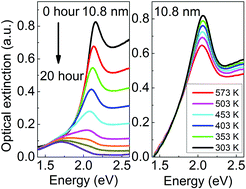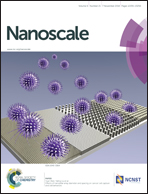Copper plasmonics and catalysis: role of electron–phonon interactions in dephasing localized surface plasmons†
Abstract
Copper metal can provide an important alternative for the development of efficient, low-cost and low-loss plasmonic nanoparticles, and selective nanocatalysts. However, poor chemical stability and lack of insight into photophysics and plasmon decay mechanisms has impeded study. Here, we use smooth conformal ALD coating on copper nanoparticles to prevent surface oxidation, and study dephasing time for localized surface plasmons on different sized copper nanoparticles. Using dephasing time as a figure of merit, we elucidate the role of electron–electron, electron–phonon, impurity, surface and grain boundary scattering on the decay of localized surface plasmon waves. Using our quantitative analysis and different temperature dependent measurements, we show that electron–phonon interactions dominate over other scattering mechanisms in dephasing plasmon waves. While interband transitions in copper metal contributes substantially to plasmon losses, tuning surface plasmon modes to infrared frequencies leads to a five-fold enhancement in the quality factor. These findings demonstrate that conformal ALD coatings can improve the chemical stability for copper nanoparticles, even at high temperatures (>300 °C) in ambient atmosphere, and nanoscaled copper is a good alternative material for many potential applications in nanophotonics, plasmonics, catalysis and nanoscale electronics.


 Please wait while we load your content...
Please wait while we load your content...